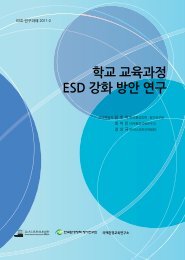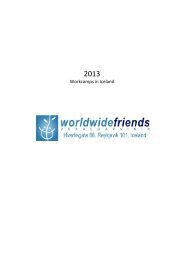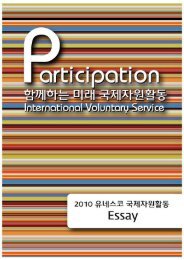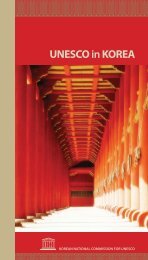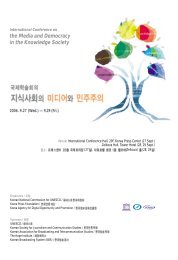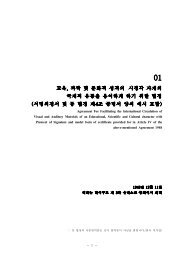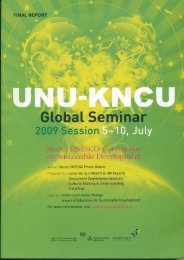íëìë³´ë2012문íì ë°ì ë¼ì´ëí ì´ë¸.pdf - ì ë¤ì¤ì½íêµììí
íëìë³´ë2012문íì ë°ì ë¼ì´ëí ì´ë¸.pdf - ì ë¤ì¤ì½íêµììí
íëìë³´ë2012문íì ë°ì ë¼ì´ëí ì´ë¸.pdf - ì ë¤ì¤ì½íêµììí
Create successful ePaper yourself
Turn your PDF publications into a flip-book with our unique Google optimized e-Paper software.
amongst medical staff. Medical units were also equipped so that patients colud decide how<br />
they wanted to be attended during childbirth, thereby leading to improved neonatal and<br />
maternal health.<br />
3. Culture is key to Inclusive Economic Development<br />
Professor Throsby’s presentation has made the case of the economic value of cultural<br />
industries. Indeed, culture in all its forms (handicrafts, festivals or performing arts, cultural<br />
institutions such as museums, or heritage sites, both natural and cultural) has proven its worth<br />
as a source of income generation and job creation, including at the community level, thus<br />
improving living conditions, fostering community-based economic growth, and contribute to<br />
empowering individuals. What is extremely important is that Culture allows for economic<br />
growth with equality and social cohesion.<br />
The weight of Culture<br />
Some figures:<br />
Cultural and creative industries represent one of the most rapidly expanding<br />
sectors in the global economy, with an average growth rate of 13.9 % in Africa, 11.9 %<br />
in South America, 17.6 % in the Middle East, 9.7 % in Asia, 6.9 % in Oceania,<br />
and 4.3 % in North and Central America , exceeding the rate of growth in service<br />
industries and manufacturing.<br />
Here again, the MDG-F Culture and Development Joint Programme implemented in<br />
Cambodia, provides ample evidence of how economic empowerment can be promoted<br />
through culture:<br />
There was an improved commercialisation of local cultural products and services in<br />
domestic and international markets through mentorship programmes in handicraft production<br />
which was provided to 63 beneficiary producer groups. This aimed at encouraging design<br />
creativity. Moreover, legal training courses were organised for producer groups to promote<br />
better understanding of related legislation for the commercialisation of cultural products, and<br />
4 baseline studies and surveys were conducted to identify potential handicraft markets and<br />
assess their tourism potential. Cultural infrastructure was developed and an Indigenous<br />
Handicraft Exhibition held at the National Museum to promote indigenous culture and<br />
improve the market space of indigenous vendors. Handicrafts sales increased, on average, by<br />
33% (approximately 50 USD), and women – as producers – own the revenue entirely



